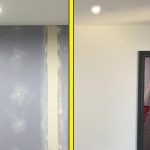There are many jobs in the construction industry that can be done in different ways.
In many cases, this will be a subtle difference in the way a job is completed. But this is usually due to how someone learned to do it. In most situations, providing the job is finished well, the end result is what really matters.
However, there are subjects that people argue about, where there is actually a definitive right and wrong answer.
One such topic, is regarding plasterboard and the correct side to skim.
For some reason, there is a small minority that insist these should be skimmed the wrong way around. So, let’s set the record straight.

You skim the white (or coloured) side of the board. The brown side is the back of the board, and it is not suitable for skimming. Also, there are several ways this can be easily proven:
- It says so on the back of the board!
- British gypsum are one of the main producer of plasterboards. On their own website, they say the back of the boards is not suitable for receiving a plaster finish.
- The white side of the board is higher quality. It is also smoother paper and has a seamless finish. Whereas the back is a rough, lower quality paper, with seams at the edges. These seams can lift with moisture. Which can cause the paper to peel away and bubble at the edges.
- Tapered edge boards have a taper on the front of the board. Ask yourself this. If the brown side was for skimming, why would the taper be on the opposite side?
So there you have it, the brown side is not designed for skimming. This should always be facing the surface the board is fixed too.
Can you plaster on the brown side of plasterboard?
These days its best practice to skim the ivory side. However, in the past there was a Widely held opinion, that the brown side was for skimming and the white side was for painting.
This is no longer the case, and the plasterboard manufacturers state this clearly on their websites. The brown side should be fitted to the back and the ivory side should face out.
The reason for this is simple. The back of the board is lower quality and more prone to failure. A common argument, is that plaster will stick to either side perfectly well, and this is very true. There should be no issue with plaster adhering to the back of the boards.
The problem is not with the plaster, the bond should be very similar on either side. However, the lower quality paper could increase the risk of problems.
Many people will skim the wrong side without any issue, but why risk it, when you can easily just skim the correct side.
The most common reason someone fits a plasterboard the wrong way round, is due to a cutting error. This will usually mean that the board doesn’t fit correctly unless its back to front.
Usually this is just one board and the plasterers never seemed to mind. So if it can’t be avoided, you should be OK. However, if you’re doing a lot of boarding, and you have spare boards, you can easily re-cut and use this piece elsewhere.
If you do have to skim the brown side, it may be worth bonding the surface with PVA prior to skimming. This will reduce the risk of your plaster blowing and should protect any paper joints.
What if you already plastered the wrong side?
If you have already plastered your boards on the wrong side, it will probably be fine. Providing the plastering has been done well, it should still give a perfectly good finish.
I telephoned the plasterboard manufacturers myself for feedback, and I was told that it’s not that much of an issue. However, they did say that they would not guarantee the boards performance if plasterboards were fitted the wrong way.
Therefore, if the paper peeled away from the gypsum, because you skimmed the back, it would void any guarantee of the product.
Again this is just another reason to do the job properly.
Essentially, you have a small downside risk when plastering the back of boards. But its also worth noting, there is no upside of plastering boards this way. Therefore, whilst the risk of issues is small, there is also nothing to gain from it.
So if the work is already done, then don’t worry, it’s probably not going to be an issue. But where you have choice, always fit the boards the right way round.
Conclusion
As with any job, there is a right way and a wrong way. In this case the correct thing to do is plaster the front of the boards and not the back.
Its not a massive issue. However, why even bother with a small risk, especially if there is no possible upside? Unless you are in a situation where it can’t be avoided, you should just do the job correctly.




